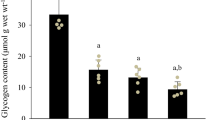Abstract
Isometric contraction of the quadriceps muscle sustained to fatigue with a force of 66% of the maximum voluntary contraction force resulted in a mean glycogen utilization of 80.4 (S.D. 58.4) mmol glucosyl units/kg dry muscle (d.m.) and an accumulation of glycolytic intermediates and glucose corresponding to 82.9 (S.D. 17.5) mmol glucosyl units/kg d.m. Accumulation of hexose phosphates (principally glucose 6-phosphate) accounted for 35.4% (S.D. 4.1) of the total increase and lactate for 59.3% (S.D. 2.8). During a 4 min recovery period glucose 6-[hosphate content showed a linear decrease with a half time of 2.0 min and lactate decreased exponentially with a half time of 2.5 min. The rate of lactate disappearance from the muscle was approximately 4 times as fast as that observed previously after maximal bicycle exercise. This was probably due to a lower lactate concentration in blood after isometric contraction resulting in a larger muscle-blood gradient for lactate. Muscle content of free glucose was increased after contraction and increased further during recovery. It is concluded that the glucose increase is confined to the intracellular pool and is an effect of hexokinase inhibition by accumulated glucose 6-phosphate. Occlusion, of the local circulation after the contraction inhibited the recovery processes for lactate and glucose 6-phosphate.
Similar content being viewed by others
References
Ahlborg B, Bergström J, Ekelund L-G, Guarnieri G, Harris RC, Hultman E, Nordesjö L-O (1972) Muscle metabolism during isometric exercise performed at constant force. J Appl Physiol 33:224–228
Bergström J (1962) Muscle electrolytes in man. Determination by neutron activation on needle biopsy specimens. A study on normal subjects, kidney patients with chronic diarrhoea. Scand J Clin Lab Invest 14: Suppl 68
Crane RK, Sols A (1953) The association of hexokinase with particulate fractions of brain and other tissue homogenates. J Biol Chem 303:273–292
Harris RC, Hultman E, Nordesjö L-O (1974) Glycogen, glycolytic intermediates and high energy phosphates determined in biopsy samples of musculus quadriceps, femoris at rest. Methods and variance of values. Scand J Clin Lab Invest 33:109–120
Harris RC, Hultman E, Kaijser L, Nordesjö L-O (1975) The effect of circulatory occlusion on isometric exercise capacity and energy metabolism on the quadriceps muscle in man. Scand J Clin Lab Invest 35:87–95
Harris RC, Edwards RHT, Hultman E, Nordesjö L-O, Nylind B, Sahlin K (1976) The time course of phosphorylcreatine resynthesis during recovery of the quadriceps muscle of man. Pflügers Arch 367:137–142
Hermansen L, Vaage O (1977) Lactate disappearance and glycogen synthesis in human muscle after maximal exercise. Am J Physiol 233:E422-E429
Jorfeldt L, Juhlin-Dannfelt A, Karlsson J (1978) Lactate release in relation to tissue lactate in human skeletal muscle during exercise. J Appl Physiol 44:350–352
Kahana SE, Lowry OH, Schultz DW, Passonneau JV, Crawford ES (1960) The kinetics of phosphoglucoisomerase. J Biol Chem 235:2178–2184
Karlsson J (1971) Lactate and phosphagen concentrations in working muscle of man. Acta Physiol Scand (Suppl) 358
Najjar VA (1962) Phosphoglucomutase. The Enzymes 6:161–178
Newsholme EA, Start C (1974) Regulation in metabolism. Wiley, London
Sahlin K, Harris RC, Hultman E (1975) Creatine kinase equilibrium and lactate content compared with muscle pH in tissue samples obtained after isometric exercise. Biochem J 152:173–180
Sahlin K, Harris RC, Nylind B, Hultman E (1976) Lactate content and pH in muscle samples obtained after dynamic exercise. Pflügers Arch, 367:143–149
Tornvall G (1963) Assessment of physical capabilities with special reference to the evaluation of maximal voluntary isometric muscle strength and maximal working capacity. Acta Physiol Scand 58: Suppl 201
Author information
Authors and Affiliations
Rights and permissions
About this article
Cite this article
Harris, R.C., Hultman, E. & Sahlin, K. Glycolytic intermediates in human muscle after isometric contraction. Pflugers Arch. 389, 277–282 (1981). https://doi.org/10.1007/BF00584790
Received:
Accepted:
Issue Date:
DOI: https://doi.org/10.1007/BF00584790




